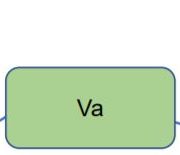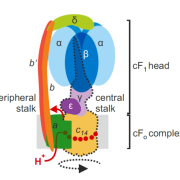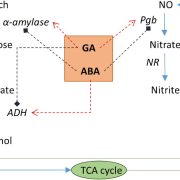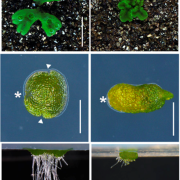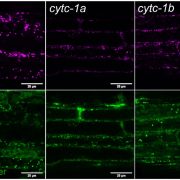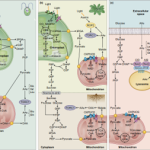TOR complex regulates actin cytoskeleton dynamics through controlling ATP levels (PNAS)
 TOR (Target of Rapamycin) complex is an information hub that integrates nutrition and energy signals and serves as a master regulator for multiple downstream cellular processes. The actin cytoskeleton in plant cells is highly dynamic, with rapid changes of its organization and constant turnover between its monomeric and filamentous forms, requiring a large energy supply. While both TOR complex and actin cytoskeleton dynamics relate to energy level, little is known about the connection between them. In this recent work from Dai et al., the connection of TOR complex 1 (TORC1) and actin cytoskeleton dynamics in Arabidopsis has been established. Using spinning-disc confocal microscopy, the authors quantified actin filament dynamics under impaired TORC1 conditions and ATP-deficient conditions. Impairment of TORC1 by genetic mutations and TOR inhibitor treatments led to decreased actin cytoskeleton dynamics and reduced sensitivity to actin inhibitors, but the organization of the actin cytoskeleton was not altered. The authors showed that inhibition of TORC1 functions led to reduced ATP levels, and actin filaments displayed reduced dynamics in ATP-deficient conditions. Further, exogenous feeding of adenine partially rescues the actin filament dynamics upon TORC1 function impairment. Using fluorescence marker-tagged functional complementation lines, the authors demonstrated that an important component of the TOR complex, RAPTOR1B, is localized to the cytoplasm and mitochondria surface, supporting an essential role of TORC1 in controlling physiological ATP production in plant cells. (Summary by Xiaohui Li @Xiao_hui_Li) PNAS 10.1073/pnas.2122969119
TOR (Target of Rapamycin) complex is an information hub that integrates nutrition and energy signals and serves as a master regulator for multiple downstream cellular processes. The actin cytoskeleton in plant cells is highly dynamic, with rapid changes of its organization and constant turnover between its monomeric and filamentous forms, requiring a large energy supply. While both TOR complex and actin cytoskeleton dynamics relate to energy level, little is known about the connection between them. In this recent work from Dai et al., the connection of TOR complex 1 (TORC1) and actin cytoskeleton dynamics in Arabidopsis has been established. Using spinning-disc confocal microscopy, the authors quantified actin filament dynamics under impaired TORC1 conditions and ATP-deficient conditions. Impairment of TORC1 by genetic mutations and TOR inhibitor treatments led to decreased actin cytoskeleton dynamics and reduced sensitivity to actin inhibitors, but the organization of the actin cytoskeleton was not altered. The authors showed that inhibition of TORC1 functions led to reduced ATP levels, and actin filaments displayed reduced dynamics in ATP-deficient conditions. Further, exogenous feeding of adenine partially rescues the actin filament dynamics upon TORC1 function impairment. Using fluorescence marker-tagged functional complementation lines, the authors demonstrated that an important component of the TOR complex, RAPTOR1B, is localized to the cytoplasm and mitochondria surface, supporting an essential role of TORC1 in controlling physiological ATP production in plant cells. (Summary by Xiaohui Li @Xiao_hui_Li) PNAS 10.1073/pnas.2122969119



